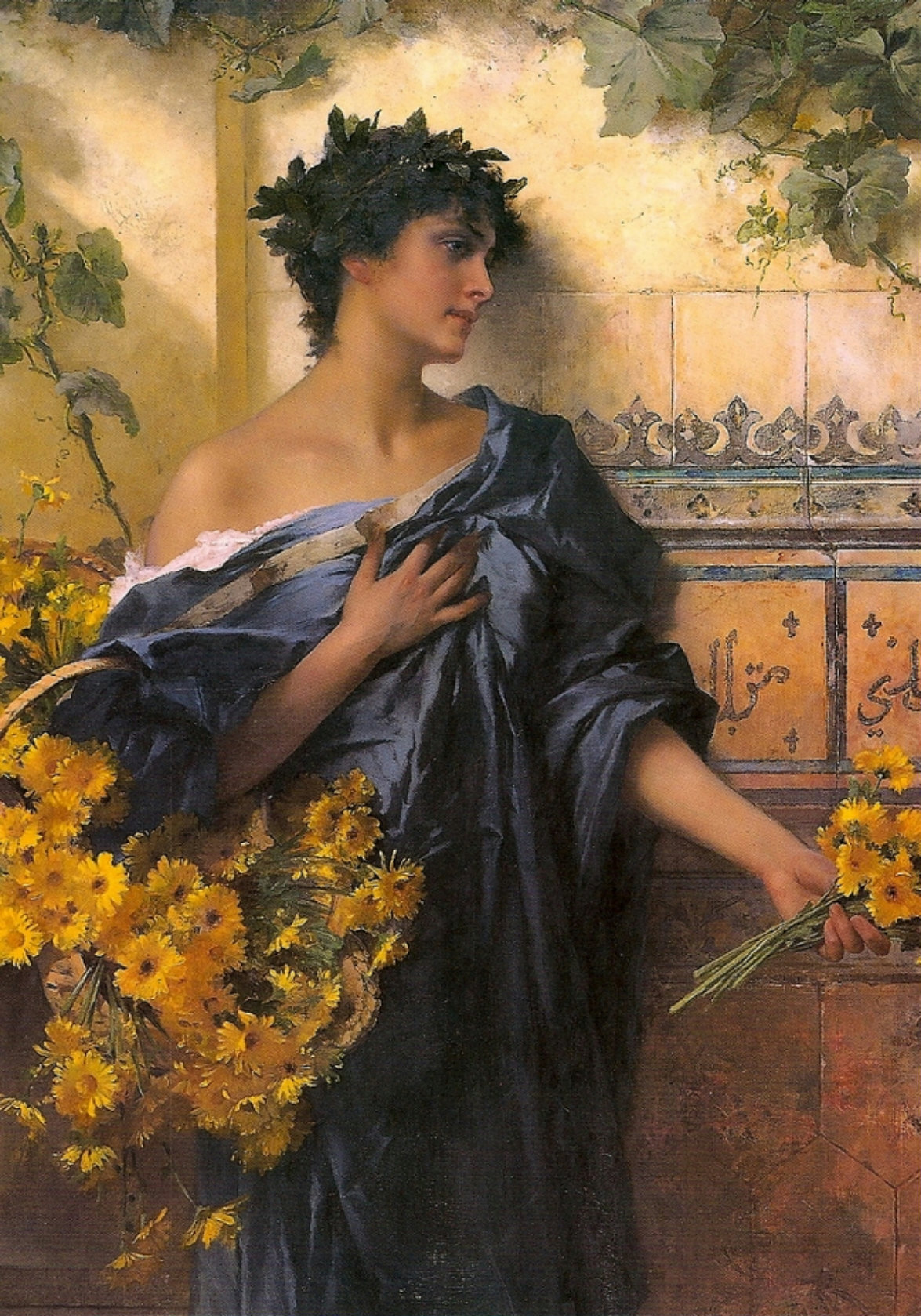Kiesel, Conrad (1846-1921), Die Blumengabe
Conrad Kiesel(1846-1921), Die Blumengabe . Öl auf Holz, 43 x 35 cm, 69 x 61 cm (Rahmen), links unten mit „Conrad Kiesel pxt [pinxit]“ signiert, um 1900. In prunkvollem Goldstuckrahmen der Zeit. Rückseitig mit altem Aufkleber einer Londoner Galerie.
- Größere, vom Künstler selbst vorgenommene Retuschen zur nachträglichen Aufhellung des Inkarnats. Das Gemälde ist in sehr gutem Zustand, der Rahmen partiell berieben und bestoßen.
Exposé als PDF
- Die Tiefe der Allegorie -
Conrad Kiesel veranschaulicht auf den ersten Blick Flora, die Göttin der Blüte und des Frühlings, und doch fügt sich die dargestellte Figur nicht in die überlieferte Ikonografie. Flora hat weder schwarzes Haar noch trägt sie einen Lorbeerkranz. Von der traditionellen Bildsprache ausgehend, schafft Conrad Kiesel eine neuartige Allegorie, die neben dem sich entfaltenden Leben auch Eros, Tod und die über den Tod triumphierende Kunst in sich einbindet.
Die Blumen veranschaulichen das aufblühende Leben, dessen Schönheit in der jungen Frau vor Augen steht. Die Blumen scheinen sich ihr förmlich zuzuwenden und ihr antikisierendes graublaues Gewand weist eine den Blüten verwandte Faltenstruktur auf, so dass es seinerseits wie ein Blütenkelch wirkt, aus dem die jugendliche Schönheit hervorgeht. Dabei lässt das Gewand nicht allein einen Blick auf ihren Oberarm zu, der zur Imagination der Schulter und dem Nachvollzug der eleganten Halslinie animiert, dort, wo die beiden rosafarbenen Chrysanthemen die jugendliche Schönheit ‚anschauen‘, ist das Gewand durchscheinend, so dass ihre Brust in einem Spiel von Ver- und Enthüllung sichtbar wird.
Das vom Eros durchwaltete aufblühende Leben wird vom schwarzen Haar und den dunklen Augenhöhlen konterkariert, mit denen allegorisch die Dimension des Todes in das Motiv hineingetragen wird. Die junge Frau ist aber auch mit dem Lorbeerkranz des ewigen Ruhms bekrönt, so dass aus der Flora eine Viktoria wird, die veranschaulicht, dass der Ruhm den Tod überwindet. Zugleich ist der Lorbeerkranz aber auch ein Symbol für die Dichtkunst, was die junge Dame zur Personifikation der Poesie und Inspiration macht und als Muse perspektiviert. Vor diesem Ewigkeitsaspekt, der auf die Kunst selbst bezogen ist, wirkt der gelbliche Fond wie ein Goldgrund, vor dem die junge Frau wie eine Heilige erscheint.
Conrad Kiesel war vor allem ein äußerst gefragter Porträtist. Bei diesem Gemälde, bei dem er keinem Porträtauftrag nachkam, hatte er die Freiheit, ganz seinen eigenen Bildideen zu folgen. Er schuf eine vielschichtige Allegorie, deren geheimnisvolle Attraktionskraft darin besteht, sich nicht endgültig auflösen zu lassen.

Während die orientalische Schönheit dort die Blumen feilbietet, entnimmt die junge Frau auf unserem Bild dem Strauß mit eleganter Geste zwei gelbe Blumen, um sie jenem darzureichen, den ihr Blick auserwählt hat und dessen Namen der sinnlich geöffnete Mund bereits auszusprechen scheint.
Der Wandel von der orientalischen Schönheit zur Allegorie erklärt die zur Aufhellung des Inkarnats vorgenommenen Retuschen. Diese Sensibilität für die Farbe zeigt sich auch in der Entscheidung, die junge Frau zwei gelbe Blumen aus dem ansonsten rosafarbenen Strauß entnehmen zu lassen. Im Verbund mit dem Graublau des Gewandes entsteht dadurch eine subtile in sich austarierte Farbspannung.
zum Künstler
Conrad Kiesel widmete sich zunächst an der königlichen Akademie der Baukunst Düsseldorf der Architektur, wechselte dann aber an die Berliner Akademie der Künste, um unter Fritz Schaper Bildhauerei zu studieren. Nach einer sechsjährigen Tätigkeit als Bildhauer entschloss er sich unter dem Eindruck einer Hollandreise, Maler zu werden. Zunächst war er Schüler von Fritz Paulsen in Berlin, um dann nach Düsseldorf zu wechseln und dort bei Wilhelm Sohn zu studieren.
„Bei Wilhelm Sohn eignete er sich koloristische Fertigkeiten an, welche er schnell zur höchsten Virtuosität, namentlich in der Behandlung von glänzenden Seiden- und Atlasstoffen entfaltete.“
Adolf Rosenberg
Nach einem Aufenthalt in München ließ sich Conrad Kiesel 1885 in Berlin nieder und wurde bis in die höchsten Kreise hinein zum gefragten Gesellschafts- und Porträtmaler. Er schuf Bildnisse von Wilhelm II. und der Kaiserin Augusta. 1886 erfolgte seine Ernennung zum königlichen Professor.
Auf den Ausstellungen der Berliner Akademie wurden er mehrfach mit der goldenen Medaille ausgezeichnet. Seine Werke waren regelmäßig auf den Akademieausstellungen in Düsseldorf und Wien und dem Münchner Glaspalast zu sehen. International stelle er 1909 in der Royal Academy of Arts aus und war 1910 auf der Pariser, und 1911 auf der Römischen Weltausstellung vertreten.

